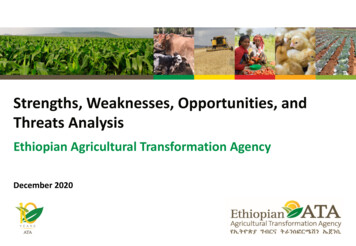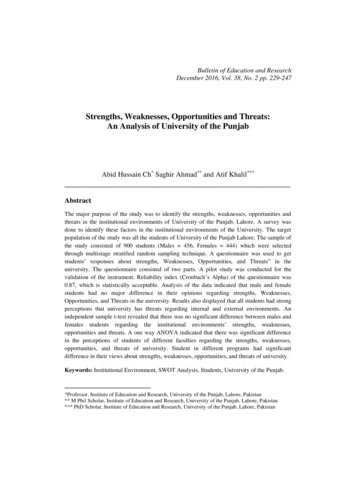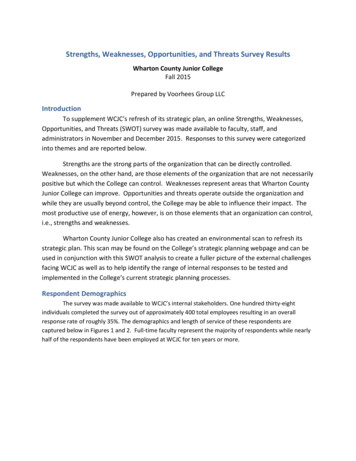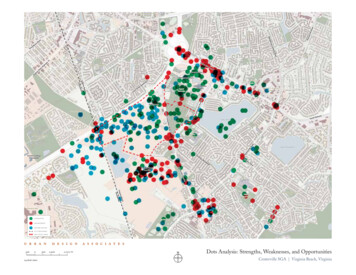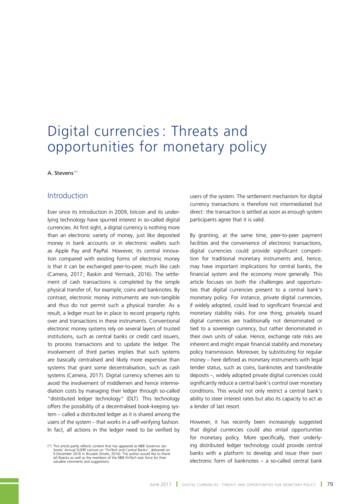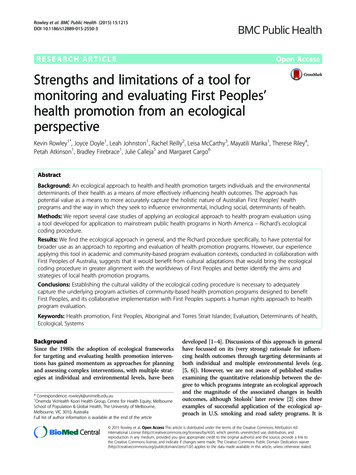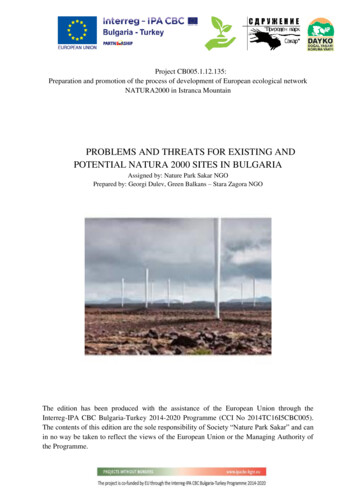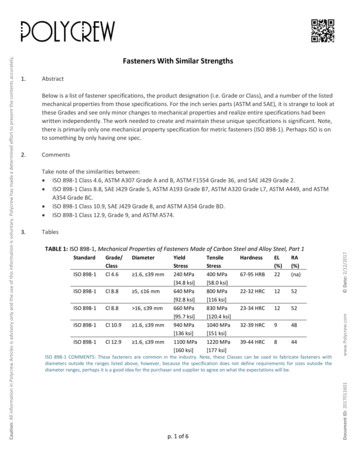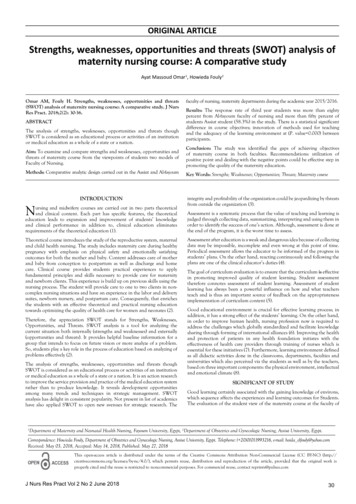
Transcription
ORIGINAL ARTICLEStrengths, weaknesses, opportunities and threats (SWOT) analysis ofmaternity nursing course: A comparative studyAyat Massoud Omar1, Howieda Fouly2Omar AM, Fouly H. Strengths, weaknesses, opportunities and threats(SWOT) analysis of maternity nursing course: A comparative study. J NursRes Pract. 2018;2(2): 30-36.ABSTRACTThe analysis of strengths, weaknesses, opportunities and threats thoughSWOT is considered as an educational process or activities of an institutionor medical education as a whole of a state or a nation.faculty of nursing, maternity departments during the academic year 2015/2016.Results: The response rate of third year students was more than eightypercent from Al-fayoum faculty of nursing and more than fifty percent ofstudents Assiut student (58.3%) in the study. There is a statistical significantdifference in course objectives; innovation of methods used for teachingand the adequacy of the learning environment at (P. value 0.000) betweenparticipants.Aim: To examine and compare strengths and weaknesses, opportunities andthreats of maternity course from the viewpoints of students two models ofFaculty of Nursing.Conclusion: The study was identified the gaps of achieving objectivesof maternity course in both faculties. Recommendations: utilization ofpositive point and dealing with the negative points could be effective step inpromoting the quality of the maternity education.Methods: Comparative analytic design carried out in the Assiut and Al-fayoumKey Words: Strengths; Weaknesses; Opportunities; Threats; Maternity courseINTRODUCTIONNursing and midwifery courses are carried out in two partsand clinical content. Each part has specific features, theeducation leads to expansion and improvement of students’and clinical performance in addition to, clinical educationrequirements of the theoretical education etical course introduces the study of the reproductive system, maternaland child health nursing. The study includes maternity care during healthypregnancy with emphasis on physical safety and emotionally satisfyingoutcomes for both the mother and baby. Content addresses care of motherand baby from conception to postpartum as well as discharge and homecare. Clinical course provides students practical experiences to applyfundamental principles and skills necessary to provide care for maternityand newborn clients. This experience is build up on previous skills using thenursing process. The student will provide care to one to two clients in noncomplex nursing situations and have an experience in the labor and deliverysuites, newborn nursery, and postpartum care. Consequently, that enrichesthe students with an effective theoretical and practical nursing educationtowards optimizing the quality of health care for women and neonates (2).Therefore, the appreciation SWOT stands for Strengths, Weaknesses,Opportunities, and Threats. SWOT analysis is a tool for analyzing thecurrent situation both internally (strengths and weaknesses) and externally(opportunities and threats). It provides helpful baseline information for agroup that intends to focus on future vision or more analyze of a problem.So, students play a key role in the process of education based on analyzing ofproblems effectively (2).The analysis of strengths, weaknesses, opportunities and threats thoughSWOT is considered as an educational process or activities of an institutionor medical education as a whole of a state or a nation. It is an action researchto improve the service provision and practice of the medical education systemrather than to produce knowledge. It reveals development opportunitiesamong many trends and techniques in strategic management. SWOTanalysis has delight in consistent popularity. Not present in list of academicshave also applied SWOT to open new avenues for strategic research. Theintegrity and profitability of the organization could be jeopardizing by threatsfrom outside the organization (3).Assessment is a systematic process that the value of teaching and learning isjudged through collecting data, summarizing, interpreting and using them inorder to identify the success of one’s action. Although, assessment is done atthe end of the program, it is the worst time to assess.Assessment after education is a weak and dangerous idea because of collectingdata may be impossible, incomplete and even wrong at this point of time.Periodical assessment allows the educator to be informed of the progress instudents’ plans. On the other hand, reacting continuously and following theplans are one of the clinical educator’s duties (4).The goal of curriculum evaluation is to ensure that the curriculum is effectivein promoting improved quality of student learning. Student assessmenttherefore connotes assessment of student learning. Assessment of studentlearning has always been a powerful influence on how and what teachersteach and is thus an important source of feedback on the appropriatenessimplementation of curriculum content (5).Good educational environment is crucial for effective learning process; inaddition, it has a strong effect of the students’ learning. On the other hand,in order to improve human health, nursing profession now is required toaddress the challenges which globally standardized and facilitate knowledgesharing through forming of international alliances (6). Improving the healthand protection of patients in any health foundation initiates with theeffectiveness of health care providers through training of nurses which isessential for these initiatives (7). Furthermore, learning environment definedas all didactic activities done in the classrooms, departments, faculties anduniversities which also perceived via the students as well as by the teachers,based on three important components: the physical environment, intellectualand emotional climate (8).SIGNIFICANT OF STUDYGood learning certainly associated with the gaining knowledge of environs,which sequence affects the experiences and learning outcomes for Students.The evaluation of the student view of the maternity course at the faculty ofDepartment of Maternity and Neonatal Health Nursing, Fayoum University, Egypt, 2Department of Obstetrics and Gynecologic Nursing, Assiut University, Egypt.1Correspondence: Howieda Fouly, Department of Obstetrics and Gynecologic Nursing, Assiut University, Egypt. Telephone: ( 20)01011993216, e-mail: hoida elfouly@yahoo.comReceived: May 03, 2018, Accepted: May 14, 2018, Published: May 27, 2018This open-access article is distributed under the terms of the Creative Commons Attribution Non-Commercial License (CC BY-NC) (http://creativecommons.org/licenses/by-nc/4.0/), which permits reuse, distribution and reproduction of the article, provided that the original work isproperly cited and the reuse is restricted to noncommercial purposes. For commercial reuse, contact reprints@pulsus.comJ Nurs Res Pract Vol 2 No 2 June 201830
Omar et alnursing help educators and staff in measuring the quality of learning thatoccurs within this vital place. Critically, we are needing to measure boththe education and environment change. Although students ‘perception ofthe learning environment has been studied and reported globally we areunaware of any reports on nursing students’ evaluation to their studyingenvironments in Egypt. Therefore, the researchers decide to carry this study.Since the student is the important member in the process of education.Thus, the authors in the current study focused on evaluation the strengthsand weaknesses, opportunities and threats of maternity course from theviewpoints of all students as a first step for make an adjustment.AIM OF THE STUDYThis study aimed to examine and compare strengths and weaknesses,opportunities and threats of maternity course from the viewpoints of allstudents of Assiut and Al- Al-fayoum Faculty of Nursing.SUBJECTS AND METHODStudy DesignComparative analytic design was used to conduct this study.Study SettingThis study was carried out in the Assiut and Al-fayoum faculty of nursing,maternity departments during the academic year 2015/2016.SubjectsOne hundred and forty of third year nursing students studying maternitycourses 70 (58.3%) student from Assiut & 70 (82.3%) of students from Alfayoum) Participants received an explanatory statement detailing the studyand were informed that all information collected might remain nameless.Tool of data CollectionQuestionnaire consists of three parts: A- First part related to students’ evaluation of theoretical part of maternitycurriculum and consists of six domains;1. The students’ evaluation of the course objectives (relevancy,organization, clarity and specificity)2. Lectures & methods of teaching (Appropriateness, availability, timesufficiency, innovation and advancing)3. Source of curriculum (Innovation, quality, completion, and easeability)4. Evaluation methods (appropriateness,relevancy, and time efficiency)objectivity,diversity,5. Teacher (capabilities and skills, flexibility and patience)6. Learning environment (The adequacy, equipped, healthy, andappropriateness).B- Second part related to student’s evaluation of clinical part of maternitycurriculum and consists of three domains;1. Clinical Course (planned, relevant to future professional, acquisitionof new skills, opportunities to re-application of the practical skills,time efficient)2. Teacher /clinical instructor (sufficient competences, skills, flexibilityand patience, efficiency and Potentials)3. Learning environment (The adequacy, equipped, conveniently,efficiency capacity, usability, and maintenance)A four-point rating scale (fair, good, very good, excellent) has been utilized.C- Part three consists of open questions about SWOT of the maternitycurriculum.Administrative designAn official approval was obtained after permission from the dean of thefaculty of nursing at Al-fayoum University & Assiut University.Ethical considerationThe study protocol was approved by pertinent research and ethicalcommittees. Informed consent was taken from every student before31inclusion in the study. Participants were assured that all their data are highlyconfidential, anonymity was also assured through assigning a code numberfor each student instead of names to protect their privacy. Data was onlyavailable to the researchers and the participants.PROCEDUREThe procedure was started at the end of the year after completion of semester.A covering letter was attached to the questionnaire indicating the aim ofthe study. Then a self-directed validated Arabic model of the questionnairewas administered to nursing students. All inquiries of students were verifiedby researchers in both faculties during their fill in questionnaire. Aftercompleting the questionnaires, all of it collected for statistical analysis.STATISTICAL ANALYSISThe data were tested for normality using the Anderson-Darling test andfor homogeneity variances prior to further statistical analysis. Categoricalvariables were described by number and percent (N, %), where continuousvariables described by mean and standard deviation (Mean, SD). Chi-squareand fisher exact tests used to compare between categorical variables wherecompare between continuous variables by t-test. A two-tailed p 0.05 wasconsidered statistically significant. All analyses were performed with the IBMSPSS 20.0 software.RESULTSThe response rate of third year nursing students was 70 out of 85 (82.3%)from Al-fayoum faculty of nursing and 70 out of 120 students Assiut student(58.3%) in the study. Findings of the study illustrated in the following tablesand figures.Table 1 shows that there was an obvious significant statistical differenceregarding feedback of students among studied groups. The feedback wasincluding, the relevancy and clarity of theoretical; course objectives; theappropriateness; availability; innovation of methods used for teachingand the adequacy; equipped; healthy; appropriateness of the learningenvironment with a statistical significant at (P. value 0.001 & 0.001 &0.000) respectively. In spite of there was difference between the percentagesof reported scores of feedbacks of students regarding curriculum source;capabilities and skills of the teacher and methods used for evaluation oftheoretical curriculum, but no significant statistical difference was noted (P.value (0.011, 0.029 & 0.020).Table 2 demonstrates that (n 21) (60%) of students in Assiut faculty ratingclinical course of maternity according to (planning, relevant to futureprofessional, acquisition of new skills, opportunities to re-application of thepractical skills, time efficient) with very good score meanwhile nearly halfof students (49.3%) in Al- fayoum faculty rating it with fair degree with astatistical significant difference at (P. value 0.006). Also (56.0%) of Assiutfaculty reported that sufficiency, capabilities and skills, efficiency, Potentialsof clinical instructor was very good vs. 46.7% of Al-fayoum faculty studentsrating the clinical instructor with good score with significant statisticaldifference at (P. value 0.001). Moreover, the evaluation of studentsregarding Learning environment (The adequacy, equipped, conveniently,efficiency capacity, usability, maintenance) was significantly statisticallydifferent (P. value 0.001) among both groups (61.3% very good in Assiutvs. 56.0% faire in Al- fayoum faculty).Comparison of course’s strengths among studied groups. It illustrates thatstudying maternity course possess many of strength points, some of thesestrengths revealed a statistical significant difference at (P. value 0.001 &002 & 0.001 & 0.005 and 0.008) respectively in both studied groups withhigh percentage among Assiut faculty in their clear plan of the curriculum(93.3% vs. 48.0%) content covered and appropriate (49.3% vs. 24.0%)using of modern teaching approach (58.7% vs. 28.0%) staff’s theoretical &clinical follow up of educational process (44.0% vs. 21.3%) and acquisi
SWOT analysis is a tool for analyzing the current situation both internally (strengths and weaknesses) and externally (opportunities and threats). It provides helpful baseline information for a group that intends to focus on future vision or more analyze of a problem. So, students play a key role in the process of education based on analyzing of problems effectively (2). The analysis of .File Size: 467KBPage Count: 7
